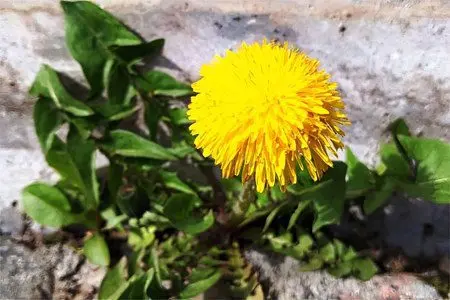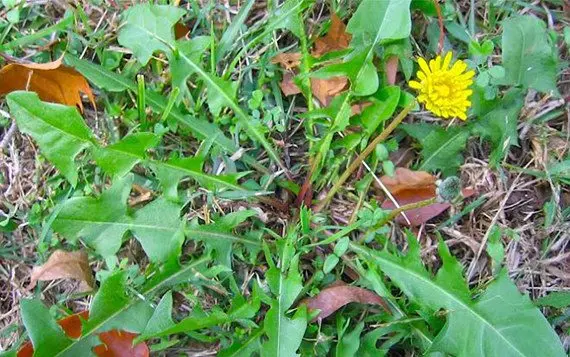
As already known, medicinal dandelion is a healing plant and very useful. From a large number of ailments and diseases, the therapeutic properties of dandelion have long been used. Dandelion appears in early spring and is one of the few plants that can start flowering in early spring and finish in late autumn. Dandelion appears immediately, as soon as the snow melts from the soil, immediately the free areas from snow begin to be covered with a dense, eye-pleasing yellow dandelion carpet.
In our latitudes, dandelion is more likely perceived as a weed, from which you can weave a children’s wreath. People think little about the value of this amazing yellow flower that looks like a small sun. Meanwhile, in some European countries, in Japan, India and the United States, dandelion is grown on special plantations and subsequently used for medicinal purposes.
What does a dandelion look like?
Dandelion medicinal or common is a herbaceous, perennial plant of the Astrov family, all parts of which contain a viscous milky juice. The rod-shaped dandelion root goes into the ground by 20-60 cm. The leaves emerge from the rosette and can be either upright or parallel to the ground. The leaf blade is rather long, oblong in shape, with pinnately dissected edges.

In spring, a leaf rosette is formed first, from the center of which comes from one to a dozen peduncles. Dandelion arrows are dense, hollow inside, crowned with a basket, which consists of more than 100 small tubular flowers. In each flower, the petals are fused with stamens.
In warm regions, dandelion bloom begins in late March or early April, in most areas – from mid-May. After flowering, in place of each small flower, an achene with a white fluffy tuft is formed.
Types
More than two thousand varieties of dandelions have been described, of which about 70 species are given special attention. They differ in geographical distribution and some external features. Let’s look at the most common:
common dandelion – the most common type of plant, which is known to everyone since childhood, abundantly covers the meadows and glades of Belarus, Ukraine, Central Asia and most of Russia.
Dandelion white-tongued – got its name from the reed-shaped white flowers that surround the central yellow ones in the middle of the basket. The species is listed in the Red Book of Russia, most often found on the Kola Peninsula.
Dandelion whitish – has pubescent leaves, yellow-white flowers. The species is common in the Kamchatka Territory, it is distinguished by its decorative qualities, unpretentiousness in cultivation.
Dandelion autumn – differs in a less lush basket of inflorescences, which opens closer to autumn, and leaves divided into more feathers. The plant is common in the Crimea, the Balkans, in the countries of Southern Europe.
Dandelion flat leaf – during flowering, it looks like an ordinary dandelion, it is distinguished by dark green, oblanceolate leaves on small petioles. The flat-leaved dandelion grows in Japan, China, Korea and the Primorsky Territory of Russia.

Benefits of Dandelion
The healing properties of dandelion have been known to mankind since ancient times. In folk medicine, it was added to products to normalize digestion, improve stomach functions, increase libido, and normalize blood sugar levels.
Official medicine confirms that different parts of dandelion are effective in complex therapy:
Cough.
Chronic constipation.
Stagnation of bile.
Helminthiasis.
Decreased immune status.
Nervous exhaustion.
The active substances concentrated in the dandelion root have a curative effect on problems of gastric and intestinal digestion. Traditional pharmacology uses dandelion roots to produce drugs that lower cholesterol, normalize sleep, and restore the functions of the nervous system.
Diuretic compositions are prepared from dandelion leaves. Juice prepared in a special way is prescribed to improve liver functions, remove stones from the gallbladder, restore the body after serious illnesses, and extensive surgical interventions.
Powdered dandelion roots are used externally. It is applied to superficial abrasions, deep wounds, burns, bedsores. Powder from the roots of the plant is valued by diabetic patients because of its ability to lower glucose levels.
Dandelion contains active substances that have a healing effect on the eyes and improve the quality of vision – lutein and zeaxanthin. Regular intake of dandelion-based products helps to cope with age-related vision loss, reduces the likelihood of developing cataracts.
Chemical composition
Fresh dandelion greens contain (per 100 g):
Calories 45 KKal
- Fats:
0,7 g
- Proteins:
2,7 g
- Carbohydrates:
9,2 g
- Water:
85,6 g
- Ash:
1,8 g
- Cellulose:
3,5 g
Vitamins | Quantity | % RDN |
Vitamin K | 778,4 mcg | 648% |
Lutein + Zeaxanthin | 13610 mcg | 235% |
Beta-carotene | 5854 mcg | 117% |
Vitamin A (retinol) | 508 mcg | 57% |
Vitamin C (ascorbic acid) | 35 mg | 39% |
Vitamin B2 (riboflavin) | 0,26 mg | 20% |
Vitamin B1 (thiamine) | 0,19 mg | 16% |
Vitamin B6 (pyridoxine) | 0,25 mg | 13% |
Minerals (in 100 g): | Quantity | %RDN |
Calcium, Ca | 187 mg | 19% |
Copper, Cu | 0,171 mg | 19% |
Iron, Fe | 3,1 mg | 17% |
Manganese, Mn | 0,342 mg | 15% |
Potassium, K | 397 mg | 9% |

Chemical analysis of dandelion revealed high levels of β-carotene, which is a powerful antioxidant. β-carotene prevents the oxidation and destruction of cells by free radicals. In the course of recent biochemical studies, it was possible to identify chicoric acid – CRA. The highest concentration of the substance was found in the leaves and stem of the dandelion. [1].
Dandelion flowers have a high level of polyphenols. Their concentration fluctuates depending on exposure to the sun. In the autumn-winter period, methylsterols are higher in dandelion, in summer, when the sunny day is longer, an increase in sitosterol and cycloartenol esters is recorded.
Dandelion roots contain:
Carbohydrates.
Carotenoid.
Fatty acid.
Minerals.
Sahara.
Choline.
Pectin.
Mucous substances.
Inulin (25–30%) and fructooligosaccharides contained in dandelion roots have antimicrobial activity against pathogens of the gastrointestinal tract. Active substances inhibit obesity, the development of malignant tumors and osteoporosis. Dandelion leaf extract is used as a flavor enhancer in drinks, in the treatment of heart disease, blood vessels, and obesity.
Dandelion components are non-toxic to the human body, so they can be used to implement anti-inflammatory, antioxidant, antirheumatic, chloretic effects.
In addition to phytochemicals, dandelion inflorescences and leaves contain carotenoids, triterpene alcohols, vitamins C and B2, B6 and P, mineral salts of iron, calcium, phosphorus, manganese, copper, boron, nickel, titanium, molybdenum and some other elements.
Looking through the entire list of properties that dandelion has, it becomes clear how many useful substances this wild plant contains and how many of them are biologically active substances for the human body. People in antiquity did not yet have scientific ideas about how rich this plant was in biochemical elements, but through their own trials and discoveries, people understood the beneficial effect of this plant on the body.
[Video] Dr. Berg – Dandelion is the most useful weed in the world:









